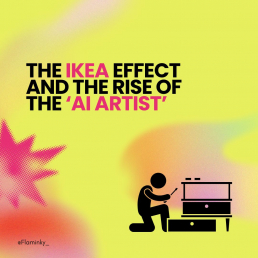
There’s a peculiar psychological phenomenon known as the IKEA Effect — named after the Swedish flat-pack furniture empire. It describes how people place disproportionately high value on things they’ve partially created themselves. In other words, if you build it (even just part of it), you’re likely to love it more.
You spend an hour assembling a wobbly bookshelf, and suddenly, it’s not just furniture — it’s a personal triumph. A reflection of you. A thing you made. That pride and ownership are powerful. But what happens when we apply the IKEA Effect to art — more specifically, AI-generated art?
The New Wave of “AI Artists”
In the past few years, we’ve seen a rise in people proudly calling themselves AI artists. Using tools like Midjourney, DALL·E, or Leonardo.Ai, users input a few descriptive words — a “prompt” — and in seconds, a beautiful, fully-formed image appears.
The result can be stunning, surreal, and emotionally evocative. And yet… the person behind it has only provided the ingredients. The AI is the real chef. Or rather, the entire factory.
This is where the IKEA Effect kicks in. Because the user typed the words, they feel they’ve created the art. Just like assembling a table with Allen keys, that sense of partial authorship gives them a burst of pride — and for some, that’s enough to claim a title like “artist.”
Prompting ≠ Craft
Let’s be clear: Prompt engineering is a skill, especially when creating complex or consistent series of images. But is it the same as studying anatomy for years to draw a human figure? Is it the same as mastering oil paint, or understanding light and texture, or dedicating your life to understanding how art moves people?
Many traditional artists feel a growing sense of frustration. They’ve trained for years — often at great personal and financial cost — to hone their craft. And now, a person with no formal experience can type “renaissance-style portrait of a cat playing the violin in a flower field” and get instant praise, clicks, or even paid commissions.
That’s not to say AI art can’t be beautiful or meaningful. But should it be valued the same way? Should the prompt engineer be celebrated like a painter, illustrator, or photographer?
Art vs Assembly: The Emotional Disconnect
Art is often about the process — the hours of sketching, revising, reworking, and the human stories behind each mark. AI shortcuts this entirely. There’s no mistake-making, no happy accident, no soulful imperfection. It’s mass generation dressed as creativity.
AI art feels good to the maker, because they’ve added the egg to the pre-made cake mix. But that’s not baking. It’s assembling. And while there’s nothing wrong with a Betty Crocker moment now and then, we should be careful about how we frame it — especially when real bakers have spent years perfecting their recipes.
The Economic and Cultural Shift
There’s also an economic layer here. Many artists now find themselves priced out of commissions — replaced by AI tools and those who can use them to undercut with speed and scale. Others see their styles mimicked and their work fed into the very data sets that power these AI tools, without permission or credit.
This isn’t just about individual recognition — it’s about the value we place on human creativity in a world increasingly defined by machines.
Final Thoughts: Don’t Dismiss the Makers
The IKEA Effect can be a wonderful thing — it reminds us that participation creates pride. But in art, we need to ask: How much participation is enough to justify the label of “artist”?
At Flaminky, we believe creativity comes in many forms. AI can absolutely be a tool in the creative toolbox. But let’s not forget — or undervalue — the people who have dedicated their lives to understanding and creating true art.
Because in a world where AI can do almost anything, what might become rare — and truly valuable — is the human hand, human struggle, and human story behind the work.
